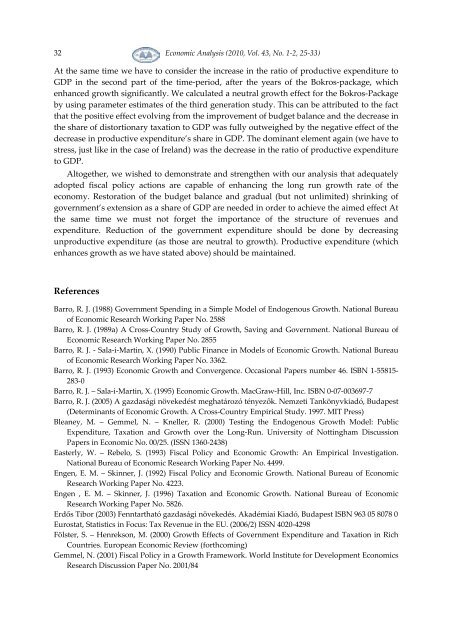Twice a Year Scientific Journal
Twice a Year Scientific Journal
Twice a Year Scientific Journal
Create successful ePaper yourself
Turn your PDF publications into a flip-book with our unique Google optimized e-Paper software.
32<br />
Economic Analysis (2010, Vol. 43, No. 1-2, 25-33)<br />
At the same time we have to consider the increase in the ratio of productive expenditure to<br />
GDP in the second part of the time-period, after the years of the Bokros-package, which<br />
enhanced growth significantly. We calculated a neutral growth effect for the Bokros-Package<br />
by using parameter estimates of the third generation study. This can be attributed to the fact<br />
that the positive effect evolving from the improvement of budget balance and the decrease in<br />
the share of distortionary taxation to GDP was fully outweighed by the negative effect of the<br />
decrease in productive expenditure’s share in GDP. The dominant element again (we have to<br />
stress, just like in the case of Ireland) was the decrease in the ratio of productive expenditure<br />
to GDP.<br />
Altogether, we wished to demonstrate and strengthen with our analysis that adequately<br />
adopted fiscal policy actions are capable of enhancing the long run growth rate of the<br />
economy. Restoration of the budget balance and gradual (but not unlimited) shrinking of<br />
government’s extension as a share of GDP are needed in order to achieve the aimed effect At<br />
the same time we must not forget the importance of the structure of revenues and<br />
expenditure. Reduction of the government expenditure should be done by decreasing<br />
unproductive expenditure (as those are neutral to growth). Productive expenditure (which<br />
enhances growth as we have stated above) should be maintained.<br />
References<br />
Barro, R. J. (1988) Government Spending in a Simple Model of Endogenous Growth. National Bureau<br />
of Economic Research Working Paper No. 2588<br />
Barro, R. J. (1989a) A Cross-Country Study of Growth, Saving and Government. National Bureau of<br />
Economic Research Working Paper No. 2855<br />
Barro, R. J. - Sala-i-Martin, X. (1990) Public Finance in Models of Economic Growth. National Bureau<br />
of Economic Research Working Paper No. 3362.<br />
Barro, R. J. (1993) Economic Growth and Convergence. Occasional Papers number 46. ISBN 1-55815-<br />
283-0<br />
Barro, R. J. – Sala-i-Martin, X. (1995) Economic Growth. MacGraw-Hill, Inc. ISBN 0-07-003697-7<br />
Barro, R. J. (2005) A gazdasági növekedést meghatározó tényezők. Nemzeti Tankönyvkiadó, Budapest<br />
(Determinants of Economic Growth. A Cross-Country Empirical Study. 1997. MIT Press)<br />
Bleaney, M. – Gemmel, N. – Kneller, R. (2000) Testing the Endogenous Growth Model: Public<br />
Expenditure, Taxation and Growth over the Long-Run. University of Nottingham Discussion<br />
Papers in Economic No. 00/25. (ISSN 1360-2438)<br />
Easterly, W. – Rebelo, S. (1993) Fiscal Policy and Economic Growth: An Empirical Investigation.<br />
National Bureau of Economic Research Working Paper No. 4499.<br />
Engen, E. M. – Skinner, J. (1992) Fiscal Policy and Economic Growth. National Bureau of Economic<br />
Research Working Paper No. 4223.<br />
Engen , E. M. – Skinner, J. (1996) Taxation and Economic Growth. National Bureau of Economic<br />
Research Working Paper No. 5826.<br />
Erdős Tibor (2003) Fenntartható gazdasági növekedés. Akadémiai Kiadó, Budapest ISBN 963 05 8078 0<br />
Eurostat, Statistics in Focus: Tax Revenue in the EU. (2006/2) ISSN 4020-4298<br />
Fölster, S. – Henrekson, M. (2000) Growth Effects of Government Expenditure and Taxation in Rich<br />
Countries. European Economic Review (forthcoming)<br />
Gemmel, N. (2001) Fiscal Policy in a Growth Framework. World Institute for Development Economics<br />
Research Discussion Paper No. 2001/84
















